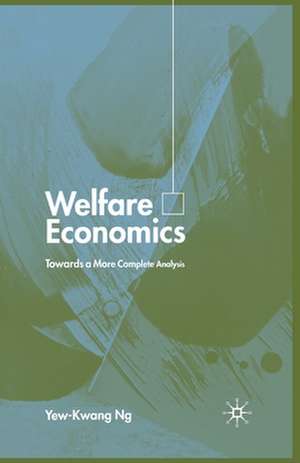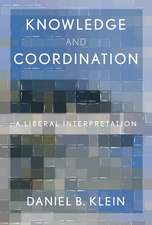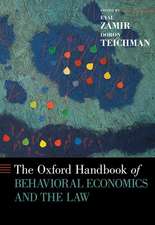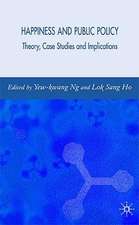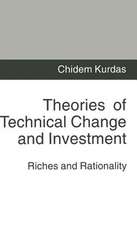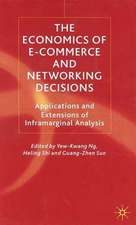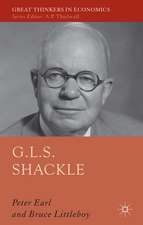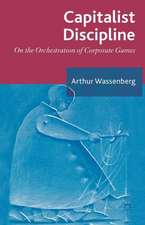Welfare Economics: Towards a More Complete Analysis
Autor Y. Ngen Limba Engleză Paperback – 2004
| Toate formatele și edițiile | Preț | Express |
|---|---|---|
| Paperback (1) | 642.36 lei 43-57 zile | |
| Palgrave Macmillan UK – 2004 | 642.36 lei 43-57 zile | |
| Hardback (1) | 646.94 lei 43-57 zile | |
| Palgrave Macmillan UK – 19 dec 2003 | 646.94 lei 43-57 zile |
Preț: 642.36 lei
Preț vechi: 755.72 lei
-15% Nou
Puncte Express: 964
Preț estimativ în valută:
122.91€ • 128.68$ • 101.70£
122.91€ • 128.68$ • 101.70£
Carte tipărită la comandă
Livrare economică 07-21 aprilie
Preluare comenzi: 021 569.72.76
Specificații
ISBN-13: 9781349429431
ISBN-10: 1349429430
Pagini: 355
Ilustrații: XIII, 355 p.
Dimensiuni: 140 x 216 mm
Greutate: 0.47 kg
Ediția:Softcover reprint of the original 1st ed. 2004
Editura: Palgrave Macmillan UK
Colecția Palgrave Macmillan
Locul publicării:London, United Kingdom
ISBN-10: 1349429430
Pagini: 355
Ilustrații: XIII, 355 p.
Dimensiuni: 140 x 216 mm
Greutate: 0.47 kg
Ediția:Softcover reprint of the original 1st ed. 2004
Editura: Palgrave Macmillan UK
Colecția Palgrave Macmillan
Locul publicării:London, United Kingdom
Cuprins
Preface List of Abbreviations List of Symbols PART 1: INTRODUCTION What is Welfare Economics? Is Welfare Economics a Positive or Normative Study Welfare versus Utility Utility Measurability and Interpersonal Comparability The Organisation of the Book Summary Appendix 1.1: Basic Value Judgements and Subjective Judgements of Fact PART 2: PARETO OPTIMALITY The Pareto Principle The Conditions for Pareto Optimality The Attainment of Pareto Optimality Summary Appendix 2.1: First-order Conditions for Pareto-optimality PART 3: THE DIRECTION OF WELFARE CHANGE: WELFARE CRITERIA The Debate on Compensation Tests Taking Distribution into Account: Little's Criterion The Inadequacy of Purely Distributional Rankings Retreat to Purely Efficiency Comparisons Quasi-Pareto Improvements Conclusions Summary PART 4: THE MAGNITUDE OF WELFARE CHANGE: CONSUMER SURPLUS The Origin of the Concept: Dupuit and Marshall Hicks' Four Measures and the Average Cost Difference Which Measure? Aggregation over Commodities: The Issue of Path Dependency Aggregation over Individuals: The Boadway Paradox The Approximate Nature of Surplus Measurement Consumer Surplus of Diamond Goods Some uses of Surplus Measurements Summary Appendix 4.1: CV, EV or Marginal Dollar Equivalent Appendix 4.2: Acceptability of the Marshallian Measure: The Benchmark Case of a Cobb-Douglas Utility Function PART 5: SOCIAL CHOICE Arrow's Impossibility Theorem The Impossibility Propositions by Kemp-Ng and Parks Can the Paradox of Social Choice be Resolved? Revealing the Intensity of Preferences A Dollar is a Dollar: A 90 per cent Solution to the Paradox of Interpersonal Cardinal Utility The Possibility of a Paretian Liberal Summary Appendix 5.1: The Incompatability of Individualism and Ordinalism PART 6: THE OPTIMAL DISTRIBUTION OF INCOME Conceptual Determination of Optimal Distribution Utility Illusion Theories of Optimal Income Distribution and Taxation: Lerner and Mirrlees Discussion Concluding Remarks Summary PART 7: EXTERNALITY The Concept and Classification of Externalities Divergence from Optimality and the Tax/subsidy Solution Other Solutions The Conscience Effect The Coase Theorem and Liability Rules Summary PART 8: PUBLIC GOODS Basic Characteristics of Public Goods Optimality Conditions and the Financing of Public Goods An Incentive-compatible Mechanism for Preference Revelation Income Distribution as a Peculiar Public Good: The Paradox of Redistribution Economic Theories of Clubs Summary Appendix 8.1: The Paradox of Redistribution and the Paradox of Universal Externality PART 9: FIRST, SECOND OR THIRD BEST? The Theory of Second Best Softening the Blow of Second Best A Theory of Third Best Towards a Third-best Policy Summary Appendix 9.1: A Dollar is Dollar - Efficiency, Equity and Third-best Policies PART 10: BEYOND MARGINAL ANALYSIS: PERSPECTIVES FROM AN INFRAMARGINAL ANALYSIS OF THE DIVISION OF LABOUR Towards a More Complete Welfare Economics Marginal versus Inframarginal Analysis Basic Inframarginal Analysis of the Division of Labour The Devastating Implications of Increasing Returns on some Traditional Conclusions The Smith Dilemma and its Resolution The Pareto Optimality of General Equilibrium in the New Framework - the Role of Entrepreneurs Welfare Economic Issues and the Division of Labour Implications Summary Appendix 10.1: A Simple Model of the Yang-Ng Framework of Specialisation PART 11: FROM PREFERENCE TO HAPPINESS Preference Economics or Welfare Economics Developments that have Prompted a Reconsideration A Simplified Analysis of Welfare Implications and Concluding Remarks Summary PART 12: CONCLUSION: TOWARDS A COMPLETE STUDY OF WELFARE Further Considerations Towards a Complete Study of Welfare Summary Appendix 12.1: Notes and References on some Advanced and Applied Topics References and Author Index Subject Index References
Notă biografică
YEW-KWANG NG holds a Personal Chair in Economics at Monash University, Australia, and has been a fellow of the Academy of Social Sciences in Australia since 1980. He has published in welfare economics, meso-economics, welfare biology, and collaborates with Professor Xiaokai Yang on an infra-marginal analysis of division of labour.
